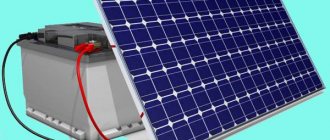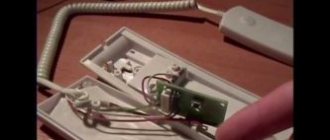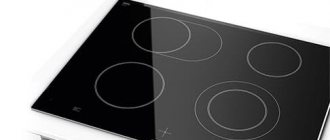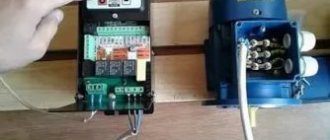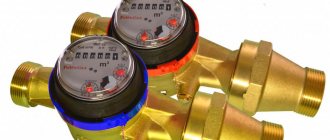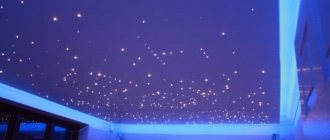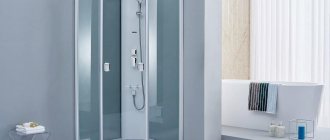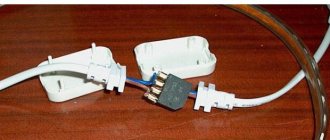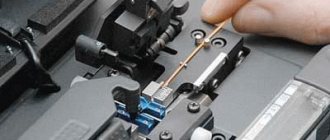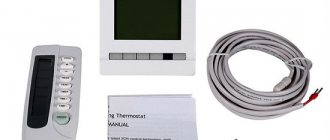Testing of fiber optic channels SCS
The need for fast transfer of large amounts of data has led to the growing popularity of high-speed Gigabit Ethernet networks and their proliferation in LAN networks.
Active network equipment of 1 and 10 Gigabit Ethernet, including routers and switches, use laser diodes rather than LEDs as radiation sources. What radiation source should be used in measurement equipment when both LEDs and lasers are used to transmit data? Let's consider this issue in more detail.
High-speed networks based on single-mode fiber use semiconductor lasers of various designs. LAN networks typically use Fabry-Perot lasers emitting at a wavelength of 1310 or 1550 nm. To measure optical signal loss in single-mode fiber, instruments with similar laser radiation sources should be used. In this case, the characteristics of the radiation source used in the testing equipment will coincide with the characteristics of the real radiation source used in the active network equipment, and the measured loss value will be very close to the actual signal loss value during network operation.
The situation with testing the cable infrastructure of networks based on multimode fiber is somewhat more complicated. In such networks, both LED and laser radiation sources can be used. Active network equipment designed for 10- and 100-Mbit Ethernet uses LEDs. At the same time, laser optical signal sources are needed to transmit data at speeds of 1 and 10 Gbit/s. VCSEL lasers (Vertical Cavity Surface Emitting Laser, surface emitting laser with a vertical resonator) are most often used to transmit data over multimode fiber. VCSEL lasers emit at a wavelength of 850 nm, they are suitable for high-speed data transmission and are much cheaper than Fabry-Perot lasers. Although the operating wavelengths of LEDs and VCSEL lasers are the same, the spatial characteristics of their radiation differ significantly (and the spectral characteristics also differ). In practice, this means that they provide different conditions for introducing radiation into the fiber. The LED relatively uniformly fills the entire core and corner aperture of a multimode fiber with radiation. VCSEL lasers emit a narrow beam with less divergence and higher brightness. The radiation beam is concentrated closer to the center of the fiber, its intensity quickly decreases as it moves away from the center; the outer part of the fiber core adjacent to its cladding is practically not illuminated (i.e., a small group of modes is excited by the laser in a multimode fiber). Different light beam input conditions result in different measured attenuation values. Typically, the attenuation measured using an LED is higher than that measured using VCSEL lasers. This factor can influence the conclusion about the operability of the network in conditions where strict requirements are imposed on the permissible optical loss budget.
Measuring TV signal in SCTV
To measure the basic characteristics of a television signal in a cable TV network (cable television network system or SCS cable network system), you will need a signal generator, a spectrum analyzer and a digital oscilloscope.
These measurements include:
- Impulse noise level. It is carried out by the method of accumulating sweeps, from the characteristics of which, using special software, such characteristics of the output signal as the width and amplitude of the pulses, as well as their periodicity, are calculated. Such measurements are carried out in conjunction with recording the level of total interference. The scan should be recorded at intervals of 2-8 seconds;
- Total interference level. Such measurements are performed using a spectrum analyzer by recording spectral analysis data of the interference, and are carried out at intervals of 8-10 seconds. Testing is carried out over eight hours. In this case, the bandwidth of the device is set:
- at intermediate frequency at 30 kHz;
- via video at 10 kHz;
- the detector is switched to peak mode.
Using the appropriate software, the spectral power is adjusted and the ratio of the signal power level and the total interference for a single channel is determined;
- Determination of the frequency response of the path. The determination of these characteristics is based on the method of analyzing the distortions of a test signal of a certain shape, supplied by a pulse generator to the input of the path. To perform such measurements, the following equipment is required:
- Pulse generator used as a source of the tested signal;
- digital high-frequency oscilloscope (with a bandwidth of up to 50 MHz), equipped with an interface for transmitting received information;
- a device for storing the obtained results connected to an oscilloscope.
The resistance at the input and output of the devices used must correspond to the indicator - 75 Ohms.
Selecting a radiation source for certification of fiber optic channels
When certifying fiber-optic lines, the TIA and ISO standards require checking the polarity of the fibers and measuring the amount of signal loss in each fiber at two standard wavelengths (horizontal wiring up to 100 m in length is sufficient to test at one wavelength.) The TIA-568-B.1 standard refers to the standard TIA 526-14, Optical Loss Measurement of Installed Multimode Fiber Cable Plant, OFSTP-14. Annex A of the latest standard defines a CPR radiation source.
Coupled-power ratio (CPR) is a qualitative measurement commonly used to describe the Mode-Power Distribution (MPD) of an optical signal as it propagates through a multimode cable. CPR is the ratio of the total power output from a multimode cable to the signal power output from a single-mode cable that is connected to a multimode cable. There is no established term for CPR in the Russian language yet.
Measuring TV signal in SCTV
To measure the basic characteristics of a television signal in a cable TV network (cable television network system or SCS cable network system), you will need a signal generator, a spectrum analyzer and a digital oscilloscope.
These measurements include:
- Impulse noise level. It is carried out by the method of accumulating sweeps, from the characteristics of which, using special software, such characteristics of the output signal as the width and amplitude of the pulses, as well as their periodicity, are calculated. Such measurements are carried out in conjunction with recording the level of total interference. The scan should be recorded at intervals of 2-8 seconds;
- Total interference level. Such measurements are performed using a spectrum analyzer by recording spectral analysis data of the interference, and are carried out at intervals of 8-10 seconds. Testing is carried out over eight hours. In this case, the bandwidth of the device is set:
- at intermediate frequency at 30 kHz;
- via video at 10 kHz;
- the detector is switched to peak mode.
Using the appropriate software, the spectral power is adjusted and the ratio of the signal power level and the total interference for a single channel is determined;
- Determination of the frequency response of the path. The determination of these characteristics is based on the method of analyzing the distortions of a test signal of a certain shape, supplied by a pulse generator to the input of the path. To perform such measurements, the following equipment is required:
- Pulse generator used as a source of the tested signal;
- digital high-frequency oscilloscope (with a bandwidth of up to 50 MHz), equipped with an interface for transmitting received information;
- a device for storing the obtained results connected to an oscilloscope.
The resistance at the input and output of the devices used must correspond to the indicator - 75 Ohms.
Network Application Requirements
Application specifications always refer to point-to-point connections, which are called "channels" in TIA and ISO. If the cable is installed or tested in segments, then care must be taken to ensure that the total loss and fiber length in each channel do not exceed the maximum allowable value to ensure normal operation of applications.
Table 4 below provides information about the maximum recommended cable length and maximum acceptable signal loss for various applications. The most stringent requirements apply to high-performance gigabit networks. Gigabit Ethernet signal loss limits are close to TIA and ISO loss limits for structured cabling systems. The requirements imposed by early network technologies on the amount of losses are much softer. The physical communication medium will not negatively impact application performance as long as the application requirements do not exceed the specifications of the TIA and ISO standards.
Table 4 Application requirements based on fiber type and emission source
Source
Review of methods for testing optical cables with a reflectometer: what to choose to test new fiber-optic lines?
Upgrading 100/400G core networks and preparing for 5G deployment requires quality testing of fiber optic communication lines (FOCL). Choosing the right techniques and suitable instruments is critical when testing fiber optics, as mistakes can be extremely costly.
No matter what modern optical networks we are talking about, the physical integrity of the fiber and the quality of the connection of the optical lines are still critical. Modernization of existing networks involves checking their condition, and laying new fiber-optic lines involves monitoring the quality of connections. The higher the fiber-optic link speeds, the more stringent the requirements for the quality of their diagnostics. And here the problem of choosing a testing methodology arises, for example, is “testing to the maximum” using bidirectional tests always the best option?
Bidirectional testing of fiber optic links with a reflectometer: panacea or new problems?
It is important to understand that fiber optic communication is closely related to reflectometry. Without a high-quality OTDR reflectometer, it is impossible to create a reliably operating fiber-optic line. Therefore, solving the problem comes down to the correct initial selection of equipment and determining the most suitable testing methods.
There are two main methods of reflectometry: one-way (one compensation coil is connected to one end of the line), two-way (with a compensation coil at the near end and the same at the far end).
The direction of the light may affect the test results. In any fiber there is a difference in the coefficients of back reflection and in one direction the light loss may be greater.
Single-sided OTDR testing can miss many anomalies. Thus, junctions of fibers with different reflection coefficients in one direction can compensate for the loss of the test signal, and in the other, significantly weaken it. In addition, there are dead zones in which the reflectometer does not register events.
The figure below shows an example of the difference in signal level loss depending on the measurement direction. On the one hand, testing even shows a negative loss of -0.3 dB, which is, of course, impossible. In this case, there is an amplification effect associated with the difference in the backscattering coefficient at the junction of the two cables.
Therefore, one-way testing of optical cables with a reflectometer is better suited for simple tests, for example, for finding and locating breaks, breaks in the fiber, as well as assessing the overall signal attenuation in the fiber, checking connectors, etc. In this case, there is no need to waste time on bi-directional testing . The main advantage of one-way diagnostics of fiber optic lines is that you only need to perform one procedure for inspecting and cleaning the optical fiber for each line. This is important, since contamination introduced into the connectors can lead to failure of the fiber-optic line, which was working properly before testing. Sometimes customers insist on two-way "full testing", but this can be redundant and even harmful, if only because of the greater risk of failure of the optical connector cleaning procedure.
Measuring a TV signal in an optical cable
The main element of fiber optic networks is the fiber located inside the optical cable. To maintain and test such systems, specialized measuring equipment is required. Here are some devices without which it is impossible to perform any measurements on optical lines:
- optical reflectometer (OTDR) – makes it possible to determine not only the level of losses in the system, but also the location of damage to the optical cable;
- optical tester - presented in the form of an independent radiation source and a device for measuring optical signal power;
- optical power meter – records the signal level indicator and displays its numerical value on its screen in Watts or dBm. The main measuring element of the device is a photodetector.
- flaw detector – causes a red glow on damaged sections of the optical cable;
- active fiber identifier – the device is designed for a quick, gentle (non-destructive cable integrity) method for determining the presence of a signal and its direction in an optical fiber. It makes it possible to detect the presence of a signal without turning off the transmitting and receiving equipment, as well as determine its strength and direction.
Let's figure out what characteristics of fiber-optic communications we are talking about when servicing and repairing them. The first indicator that experts pay attention to is the level of attenuation of the optical signal at a certain wavelength (measured in dB). This value characterizes the quality of the fiber optic cable and the level of installation work performed during its installation. The main elements of the system that cause this process to occur are:
- optical fiber (losses are measured in dB per unit distance);
- welding connections;
- connectors;
- connectors;
- dividers, etc.
The next important characteristic for optical communications is back reflection. This value determines the power of the signal reflected to its source and is also expressed in dB. The main reasons for the occurrence of a reflected signal, as a rule, are mechanical damage to the optical cable (cracks), the presence of mechanical connectors, or a cable break at the connection point (free end).
The use of the above devices allows a specialist to achieve the output signal to the required level and ensure reliable operation of the receiving equipment located in the apartment or house. So, if you have problems with the image in SCTV conditions, you should contact the operator who provides these services to you.
- How to check a TV cable
- How to improve TV quality
- How to improve the quality of cable TV
- — Multimeter (tester);
Hello, dear readers of the blog Man in the House.Ru. In today's article, as you probably already understood, we will look at the most common causes of malfunctions in the operation of a satellite dish and ways to eliminate them.
It's no secret that you can repair satellite dishes yourself. Calling a specialist for tincture can cost you unreasonably expensive. To save your family budget, let's look at how to repair the satellite system yourself.

